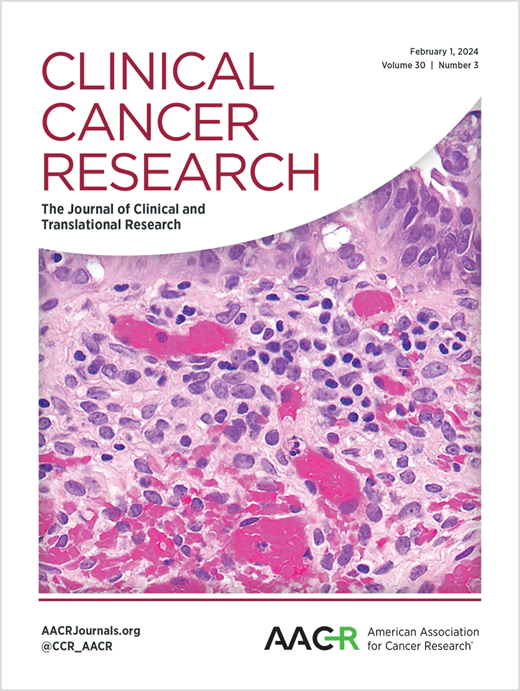放射免疫治疗低转移性疾病的现状与希望。
IF 10
1区 医学
Q1 ONCOLOGY
引用次数: 0
摘要
低转移状态,以有限的转移传播为特征,挑战了转移性癌症广泛且无法治愈的观点。有证据表明,局部治疗(如手术或立体定向全身放射治疗(SBRT))可能会使有限转移的患者获得长期疾病控制甚至治愈。放疗对肿瘤微环境产生复杂的剂量依赖性效应,包括免疫原性细胞因子和损伤相关分子模式(DAMPs)的释放,癌细胞抗原呈递增强,效应T细胞、自然杀伤细胞(NK)细胞和巨噬细胞的浸润。这些免疫调节作用为SBRT联合免疫检查点抑制剂(ICIs)增强局部和全身抗肿瘤免疫提供了强有力的基础。几项前瞻性I-II期试验研究了放射治疗和免疫治疗在低转移患者中的各种组合,显示出可接受的安全性和有希望的疗效信号。然而,联合放射免疫治疗的临床结果在很大程度上是混合的,这可能反映了SBRT剂量、治疗顺序、免疫治疗类型、患者选择和肿瘤特征的可变性。值得注意的是,对所有转移部位采用综合消融SBRT的研究似乎更一致地显示出优于标准护理全身治疗的结果,而不是亚消融或单病灶放疗。推进放射免疫联合治疗低转移性疾病的治疗模式需要改进基于临床、分子或放射学特征的患者选择;严格优化放疗剂量分级,最大限度地提高免疫启动,同时尽量减少毒性;合理整合针对互补免疫途径的新型免疫治疗剂。本文章由计算机程序翻译,如有差异,请以英文原文为准。
Facts and hopes in radioimmunotherapy of oligometastatic disease.
The oligometastatic state, characterized by limited metastatic dissemination, challenges the view that metastatic cancer is widespread and incurable. Evidence suggests that select patients with restricted metastases may achieve long-term disease control or even cure with local therapies, such as surgery or stereotactic body radiation therapy (SBRT). Radiotherapy induces complex, dose-dependent effects on the tumor microenvironment, including the release of immunogenic cytokines and damage-associated molecular patterns (DAMPs), enhanced antigen presentation on cancer cells, and infiltration of effector T cells, natural killer (NK) cells, and macrophages. These immunomodulatory effects provide a compelling basis for combining SBRT with immune checkpoint inhibitors (ICIs) to enhance local and systemic anti-tumor immunity. Several prospective phase I-II trials have investigated various combinations of radiotherapy and immunotherapy in the oligometastatic setting, demonstrating acceptable safety profiles and promising efficacy signals. However, clinical outcomes reported with combined radioimmunotherapy have largely been mixed, which likely reflects variability in SBRT dosing, sequencing of therapy, type of immunotherapy, patient selection, and tumor characteristics. Notably, studies employing comprehensive ablative SBRT to all metastatic sites appear to more consistently demonstrate superior outcomes over standard-of-care systemic therapy, as opposed to sub-ablative or single-lesion irradiation. Advancing the therapeutic paradigm of radioimmunotherapy combinations for oligometastatic disease requires improved patient selection based on clinical, molecular, or radiographic features; rigorous optimization of radiotherapy dose-fractionation to maximize immune priming while minimizing toxicities; and rational integration with novel immunotherapeutic agents that target complementary immune pathways.
求助全文
通过发布文献求助,成功后即可免费获取论文全文。
去求助
来源期刊

Clinical Cancer Research
医学-肿瘤学
CiteScore
20.10
自引率
1.70%
发文量
1207
审稿时长
2.1 months
期刊介绍:
Clinical Cancer Research is a journal focusing on groundbreaking research in cancer, specifically in the areas where the laboratory and the clinic intersect. Our primary interest lies in clinical trials that investigate novel treatments, accompanied by research on pharmacology, molecular alterations, and biomarkers that can predict response or resistance to these treatments. Furthermore, we prioritize laboratory and animal studies that explore new drugs and targeted agents with the potential to advance to clinical trials. We also encourage research on targetable mechanisms of cancer development, progression, and metastasis.
 求助内容:
求助内容: 应助结果提醒方式:
应助结果提醒方式:


